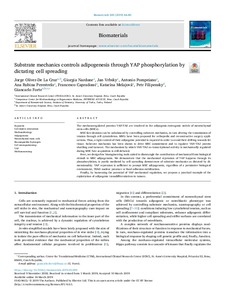Substrate mechanics controls adipogenesis through YAP phosphorylation by dictating cell spreading
Forte G.; Vrbsky J.; Oliver-De La Cruz J.; Capradossi F.; Melajová K.; Perestrelo A.R.; Filipensky P.; Nardone G.; Pompeiano A.
https://urn.fi/URN:NBN:fi-fe2021042827035
Tiivistelmä
The mechanoregulated proteins YAP/TAZ are involved in the adipogenic/osteogenic switch of mesenchymal stem cells (MSCs).
MSC fate decision can be unbalanced by controlling substrate mechanics, in turn altering the transmission of tension through cell cytoskeleton. MSCs have been proposed for orthopedic and reconstructive surgery applications. Thus, a tight control of their adipogenic potential is required in order to avoid their drifting towards fat tissue. Substrate mechanics has been shown to drive MSC commitment and to regulate YAP/TAZ protein shuttling and turnover. The mechanism by which YAP/TAZ co-transcriptional activity is mechanically regulated during MSC fate acquisition is still debated.
Here, we design few bioengineering tools suited to disentangle the contribution of mechanical from biological stimuli to MSC adipogenesis. We demonstrate that the mechanical repression of YAP happens through its phosphorylation, is purely mediated by cell spreading downstream of substrate mechanics as dictated by dimensionality. YAP repression is sufficient to prompt MSC adipogenesis, regardless of a permissive biological environment, TEAD nuclear presence or focal adhesion stabilization.
Finally, by harnessing the potential of YAP mechanical regulation, we propose a practical example of the exploitation of adipogenic transdifferentiation in tumors.
Kokoelmat
- Rinnakkaistallenteet [19218]
